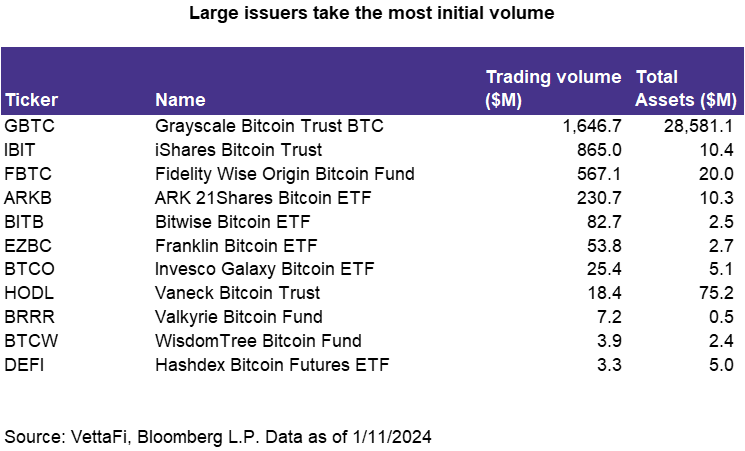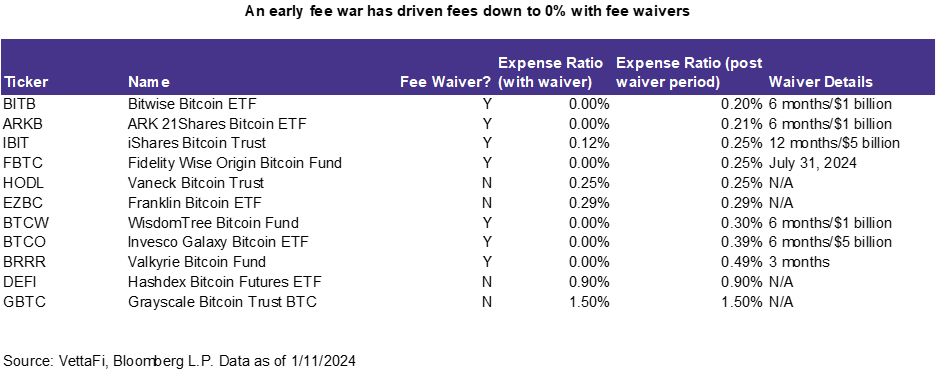After several years of uncertainty, spot bitcoin ETFs were finally approved by the SEC on January 10. The spot bitcoin ETF launch was monumental in several ways:
- Widening access to both retail and institutional investors
- Legitimizing bitcoin as an asset
- Setting precedence for high-profile ETF
These are quick takeaways from the first (half) day post-launch.
- The anticipation was more exciting than the event itself. In the weeks leading up to the launch, bitcoin prices rallied on any positive spot bitcoin ETF news. This includes the Grayscale win, the ether futures ETF launch, and other news of progress. After the launch, Bitcoin prices briefly hit around $49,000. Prices are now essentially flat. This suggests that the build-up toward the event was so long that it was already priced in by yesterday. From here, spot bitcoin ETFs still have a chance to drive bitcoin prices higher depending on what sort of demand they see in the long term, particularly over the next few days.
- Demand is the biggest driver for now. With much of the approval already priced in — particularly with the false alarm the day before — inflows will likely drive the biggest story. The big questions are — how much demand will these products have? And will there be a clear winner? So far there has been over $3.5 billion traded as of around noon ET on 11/11 (first trading day). Some of the trading volumes for GBTC, however, might be outflows into lower-cost products. Not including GBTC, the flows for the ten products are just under $1.9 billion. I’m not surprised that the iShares and Fidelity products have the most volume since these are two of the largest, most well-known issuers in the ETF world. I am surprised that the Ark 21Shares and Bitwise products are further behind given that they are significant crypto players, and crypto players took a lot of market share for crypto equity ETFs. But with not even a full day of trading data, there is still a lot of time for things to change.

- Who is buying these products? We don’t yet have this data. But there are several theories. First of all, most of the volume might be driven by institutional investors who are limited to trading securities. On the retail side, there are both existing investors and potential investors. Existing bitcoin investors may prefer a spot bitcoin ETF since they can more easily visualize the asset alongside their brokerage account. These investors typically won’t be using bitcoin as a store of value and won’t mind cash relative to in-kind redemptions. These investors might also be exiting futures products like the ProShares Bitcoin Strategy ETF (BITO) in exchange for a spot bitcoin ETF product. Potential investors may not have any experience with crypto yet but perhaps want to add a small portion of the asset to their portfolios for the diversification and return potential. Since these types of investors may be more hesitant about holding an emerging asset, they may be more likely to look at larger issuers like BlackRock and Fidelity regardless of a small difference in fees.
- With no first-mover advantage, fees are the biggest differentiator. The spot bitcoin ETF launch led to 11 nearly identical products being released at the same time. The main differentiator is fees. We said that for the ether futures ETF launch and that ended up being true—the cheapest product which is the VanEck Ethereum Strategy ETF (EFUT) currently has the most assets (followed closely behind by the Proshares Ether Strategy ETF (EETH)). This has been an even larger differentiator for spot bitcoin ETFs which engaged in an early fee war before the launch. Many of these products are offering 0% fees with fee waivers. Post fee waiver period, these fees are still considerably low (0.2%-0.5% on average). The Grayscale Bitcoin Trust (GBTC) sticks out with its 1.5% fee. However, Grayscale could technically be considered the first mover. It has the scale and assets to justify a higher price compared to newer entrants who are competing for assets.

- Next Big Story: Spot Ether ETFs? I don’t think there is as much demand for spot ether ETFs (particularly from the retail side). But the SEC is set to decide on spot ether ETFs in May. This date comes shortly after the crypto halving event. This event that occurs every four years and is often followed by an extended price rally. The same precedent applies to ether futures and ether spot ETFs as it does for bitcoin futures and bitcoin spot ETFs. Because there are ether futures ETFs, there will most likely be spot ether ETFs. However, given the SEC’s sustained reluctance toward digital assets, I don’t think we will see any other sort of digital asset ETFs emerge any time soon (i.e., no Litecoin, Solana, or XRP ETFs).
VettaFi will be hosting its first Cryptocurrency Symposium webcast on January 12, 2024 at 11 AM ET. Click here to register.
For more news, information, and analysis, visit the Crypto Channel.

